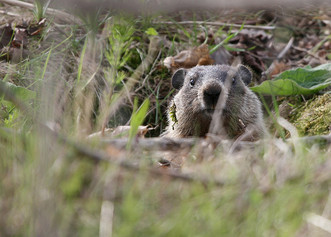 "Photo of a Groundhog in Toronto, Ontario" by qmnonic (Matt MacGillivray)
One Well-Grounded Writing Tip
Many blog writers and online journalists pursue the latest trends, chasing news items as they become popular. Today's writing tip is to include seasonal and annual events in your writing mix. They should become popular once a year without any additional effort on your part. However, you may need to update some of the information annually.This groundhog article certainly received quite a few visits for the first few days of February 2013. I'm not sure whether I will add another update at the front for 2014, or write a completely new article.An article about indoors Christmas decorations, or perhaps introducing Kwanzaa holiday entertaining, will only be popular for a few weeks in the year. But it might be very popular during that time. Meanwhile, an article that combines nutrition with a special day might earn readers all year long, but with a spike at the right time. " Choosing Chocolate or Carob as a Valentines Day Gift" is an example. Remember that events on a lunar calendar drift across months, while most annual events in the familiar Gregorian calendar change the day of the week. Others are pinned to a specific day, so the date changes from year to year. Examples include: - "Celebrating the 2012 Hanukkah in Toronto" is a lunar event; so are Easter, Chinese New Year, and Ramadan.
- Canada Day or the American Fourth of July dates fall onto whatever day of the week they happen to land. However, the national holiday might be pushed or pulled to make a long weekend. That information
- The American Presidents Day holiday was originally Washington's Birthday, but is now celebrated on the 3rd Monday of February. I've noticed that many annual races in Toronto follow the pattern of being the nth Sunday of a particular month...even if there is no holiday associated with it. Canadian Thanksgiving follows a similar pattern.
To summarize the well-grounded writing tip based on celebrating Groundhog Day in Canada: include annual events in your mix of articles; make updates each year if needed.
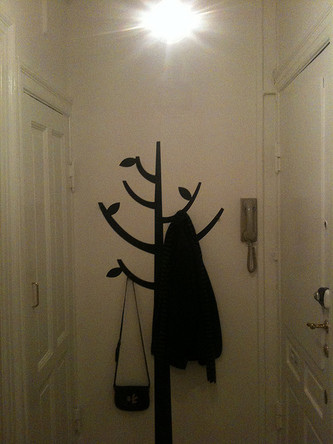 "Coat Stand Tree in use" by jacobms (Jacob Munk-Stander)
One Rather Wooden Writing Tip
Today's wooden writing tip is that the DeHaan Services article is an experiment in marketing my previous articles through a new one.
I could have reminded people on Facebook or Google+ about each of my earlier articles. Or I could have updated them and hoped that search engines would notice.
This time, however, the approach was to use keywords in the new article to make it popular enough for readers to find.
The next step for those readers should be, one hopes, to click and follow the links.
The articles might discuss wooden furniture built according to Shaker tradition or in the Mission style, but the business
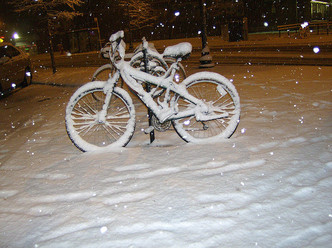 "A Bicycle in Winter Snow in Arlington, Virginia" image by *Sally M* (Sally Mahoney) What does bicycling in Toronto during the winter have in common with Robbie Burns Day? Are they actually opposed?
Free Bike Rental for One Winter Event in Toronto
It all becomes clear in " Bike in Toronto a Week after Robbie Burns Day 2013", my latest article about winter Toronto events in DeHaan Services. The common point is that Cycle Toronto, which organizes the annual "Coldest Day" bike ride for Jan. 30th, had also arranged for people to reserve free bike rentals from Bixi. However, punters have to book their free bicycle rental by Robbie Burns Day, January 25 (2013).My article links to the official cycling site, and also to one Toronto civic museum that offers a taste of haggis to celebrate the Scottish poet's birthday. (It also answers "What is haggis"?, a question is rarely asked twice). My article avoided linking free bike rentals with the stereotype of Scottish frugality.Toronto of course also has bike shops for those seeking cheap bicycles for winter cycling. Perhaps I could have played up that point as well. Publicity for Robbie Burns and Bicycling in Winter
Two Cold-Hearted Writing Tips
While I did spend time looking for keywords to lead readers to my article, I must confess that there are few links between bicycles and Burns. The reason for combining both in one article is simply that both topics hit their deadline today. It is Robbie Burns' birthday; and the bike rental offer must be taken up today.My excuse for the bike story is that I didn't know about this annual winter event in Toronto until this morning, when I also learned about the rental deadline. I have no excuse for Robbie Burns day; it's been sitting in my "DeHaan Lens of Annual Toronto Events" for ages. The first writing tip is to make a to-do list for your writing, and then check it regularly. I use that Squidoo Lens to publicize my articles, and also to track of topics for future projects. If I had read that Lens a week ago and noticed Burns Day, I could have done the research and publicized the event with some time to spare. Perhaps it would have garnered some more page views, too. Now the article dilutes its effectiveness by touching on two topics.The second writing tip is to make a virtue of necessity if you've become needy. I did manage to stitch together the two topics, with a bit of a segue from Robbie Burns to the bicycle event. Both the winter cycling event and the Burns Dinner deserved more lead time than I gave them. However, readers would easily be able to find the information that I had available; and they might even enjoy the excursion to the other topic on a winter day.
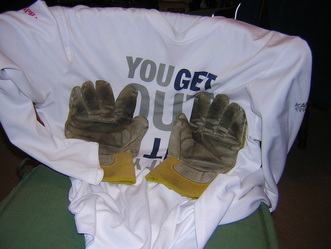 "Winter Running Shirt and Gloves" image by Mike DeHaan
Warm Up with this Writing Tip from Winter Running Wear
Today's writing tip is short, and hopefully won't "leave you cold". Three thoughts were in my mind yesterday:- I must go out for a quick training run.
- It's about time to write a DeHaan Fitness article.
- Should I wear anything different today, based on the weather conditions?
It didn't take long for that combination to inspire the topic for the article. I then took a few pictures of what I did, and didn't, choose to wear. I wrote the article after finishing my run.
This writing tip is pretty familiar to regular readers: take inspiration from what you're doing, and what happens nearby.
In this case, I was already very famliar with the subject matter. (I've been running over a dozen years, and listened to quite a few Running Room "clothing talks" in the various seasons). I still did some research, but there weren't too many surprises.
What are your skills and areas of knowledge? What hobbies or sports fill your life? Write about what you know; write about what you do. That's today's writing tip. For me, the inspiration yesterday came from deciding whether or not to wear my gloves for a short training run in
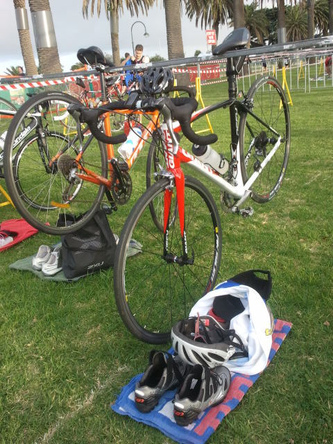 "Triathlon Transition Zone in St. Kilda" image by pfctdayelise (Brianna Laugher) Triathletes have a choice of two organizers, each with a separate venue and month, for competing in Toronto. Probably the main distinction for a triathlete is the distance. These triathlons in Toronto cover the Olympic distance, Sprint distance, Give-it-a-Tri distance; as well as a Duathlon and relay over some of these distances. My " The Usual Pair of Toronto Triathlon Competitions in 2013" covers as many details as triathletes need in my recent DeHaan Services article. As always, my Xanga blog (" They're Back: the Twin Toronto Triathlon Events in 2013" ) also publicizes my article.
One Competitive Writing Tip
Today's competitive writing tip may repeat what I've said before. Don't be afraid to a topic that you've covered before.Last year it took me about three articles to cover these triathlons. " To Untangle Two Toronto Triathlons in 2012" has my eventual explanation about the different organizations. (That hadn't been clear to me when I first learned Toronto hosts triathlons at all). During 2012, especially the first half, these triathlon articles were quite popular.This year, all I really needed to do was to find the registration pages for these triathlons and explain which organization supports which distances.The writing tip is to revisit topics if appopriate. Many "Toronto Events" will recur annually, so there's a ready supply of material. Holidays and seasonal topics have the same pattern. Perhaps less predictable are health concerns or other topics that pop up from time to time.Once you develop an expertise for a topic, consider adding new articles from time to time as the need and interest resume.
 "Toronto Design Offsite 2013" detail from the TO DO web site (modified by Mike DeHaan) Having gone too long without a Toronto event, DeHaan Services needed to publicize something free or inexpensive. The " The 2013 Toronto Design Offsite Festival" fits this requirement. TO DO, as it calls itself, celebrates great Canadian graphic and industrial design. It's an annual one-week festival, held at different venues in Toronto.However, many of the exhibits remain available for up to one month.My article points to their official web site, and highlights a few of the events that caught my eye.Of course my Xanga blog also promotes that article, in " The TO DO Design Festival in Toronto"
The Design of a Writing Tip
Some previous writing tips have suggested that you stay alert for topics. Today I already had my topic. In fact, the article was about 80% complete before I alertly found a gem. Whenever I write about a multi-faceted event, I prefer to mention a few details. In this case, I put the spotlight on an art installation and also on an educational workshop. (By the way, this workshop asks for "payment" by barter rather than money. That's very cool and worthy of further investigation). I noticed another art exhibit because I like ash wood in furniture, and the name for that display was intriguing. Their blurb explained that they use wood from ash trees culled due to emerald ash borer infestations.I'd written several articles on that very topic! This gave me the excuse to link back to my promotional post " Complementary Reports on the Emerald Ash Borer and Ash Trees" and to my news article " Emerald Ash Borer Closes Parks for Tree Removal in Oakville". This well-designed writing tip encourages you to stay alert for sub-topics within your main article, especially when you had already written about the sub-topic. These provide opportunities for self-promotion and to demonstrate that you were ahead of the times back when you wrote the original report.
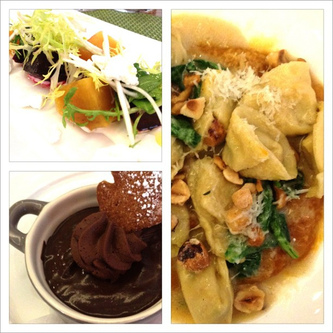 "Winterlicious Lunch at the Chef's House" image by ijokhio Toronto Winterlicious 2013 is now accepting reservations, so it's definitely time for " Prepare to Savour 2013 Winterlicious in Toronto" to guide diners to the official web page. It might be more important for newbies to learn how to make the most of that site. On the other hand, a brief word about "prix fixé " might be helpful here.A "prix fixé " meal is one at a "fixed price" for appetizer, main course and dessert. Each restaurant participating in Winterlicious in Toronto chooses from a set of prices, then offers a limited set of introductory options. This takes advantage of mass advertising, and can mean real opportunity for bargains at some of the best restaurants in Toronto. I classify Winterlicious as a recurring winter event in Toronto, so it has a place in DeHaan Services. Naturally, my article is also publicized in my Xanga blog (" Why does Winterlicious in Toronto Feature Prix Fixe Dining?" ).
One Tasty Writing Tip for Winterlicious in Toronto
I wrote my first DeHaan Services blog article (that didn't simply introduce my business) in January of 2010. " WinterCity versus Winterlicious in Toronto" began my fascination with Toronto events. It also fed my interest in research. In that case, my initial question was "Are there two different events in Toronto with similar names? If so , why"? The writing tip is to notice and cultivate what interests you, then write about it. Yes, you need an audience exists for your hobby or passion. But if you're not interested, you won't do the research or the inspiration to write well about the topic, anyway. For your own writing, you're the cook. And cooks must taste their cuisine. Enjoy your own tasty creations, just as many Toronto chefs will enjoy tuning the prix fixé meals for Winterlicious 2013.
 My " OLG Proposal and Links to Toronto Casino Consultation" provides background information, links to source material, and the all-important link to the online questionnaire for providing opinions on the Ontario Lottery and Gaming ( OLG) corporation's proposal to put a casino into downtown Toronto. Plus it includes the dates for public consultation meetings.Naturally such a sizable public service announcement also deserves publicity in my Xanga blog (" Background for the Toronto Casino Proposal" ).
A Tiny Business Case for this Toronto Casino
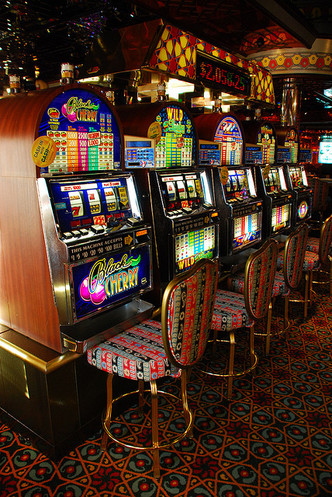 "Slot Machines Primed for Action" : image by Lisa Brewster Then Decoded Science published my " Sample Case Study of Math for a Casino Business Proposal". This examines one main detail: the very different estimates of the "hosting fee" that the OLG might pay Toronto for the privilege of making a significant profit for the province and the casino operator from the city's residents and tourists. I departed from my usual practice by pre-publicizing this article in DeHaan Services rather than here in my Blog of Writing. My original images, from the spreadsheet, were copyrighted in " Preview of Math for the Toronto Casino Proposal" because of the previous article about the OLG proposal.
Gamble on my Writing Tip
Since this article about the proposed Toronto casino is for public service, it must demonstrate that a certain quality of research.
Unfortunately, having links throughout the article slows down the reader. Without them, however, there's no way to demonstrate that the article is authoritative.
The most interesting challenge was to make all my remarks about one reference article, before moving on to the next. Otherwise the reader has to jump around the references. I wasn't perfect this time, but it was as close as I could make it.
So my writing tip is to organize an essay by the reference material, just to make life easier for your readers.
If your topic depends less on the references, you could be organize the material in other ways: by date and time; by importance; or by any logical relationship.
Just don't gamble that your reader will keep track of which source material is being referenced, even if they're interested in a risky project like a casino in Toronto.
 Adding Fractions without an Explanation Once again we preview several home-made images for an upcoming Decoded Science article.
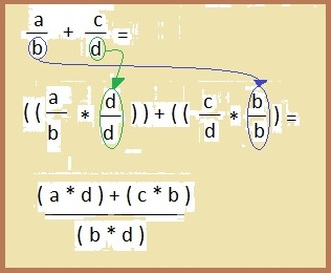 Adding Fractions with Explanation #1 ( Updated Jan. 13, 2013): We've finally published " Adding Fractions: Using a Common Denominator"! The usual pair of publicity articles were added on Jan. 14th, so this is now "done and dusted". My apologies for the delay, especially with images before the articles were published. However, this page has to be available online to take "first place" in the race to publish.Amusingly, my stalwart editor actually improved on the three similar images that I had provided. Only my "How to Add Fractions" effort survived.(Updated Jan. 7, 2013): Amusingly, as I began writing this Decoded Science article, I realized that "addition" had to begin with "vocabulary". Rather than write a double article, which would once again grieve my editor, I broke the topic into two fractions.The first part is " What Are Fractions? Math Vocabulary for Parts of a Whole", published to the Web on January 7, 2013.
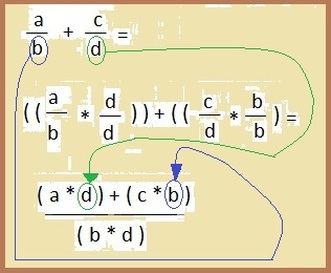 Adding Fractions with Explanation #2 Self-made images have an implicit copyright through the first site in which they are published.
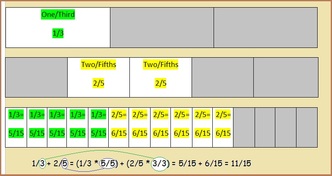 How to Add Fractions By publishing my images in a site that I control, it's pretty obvious that I have the copyright.
This might have been disputed if they went directly to another publication.
Publicity for Introducing Fractions
One Improper Writing Tip states that Size Matters
The "improper" word stems from fractions being either "proper" or "improper". Proper fractions have a value between zero and one. Improper fractions are greater than one, such as 17/4 which is more often shown as "4 1/4".
This writing tip explains how an "improper" article became "proper". Or, more accurately, why I divided an oversize essay in half.
The most frequent criticism from my Decoded Science editor is that my articles stretch to the boundary of what she wants for that site.
In my view, however, it's tricky to write for an audience who may not know enough of the background. So I often include enough material for an extra article.
This time, I caught myself in the act of having more appetizer than first course. Then I also took corrective action, spinning off the introduction as a separate article to explain the math vocabulary.
This writing tip is to keep focus on one topic when writing online. Readers who need the vocabulary will be able to link back from the "how to add fractions" article; but no-one should be intimidated by having too many pages in one article.
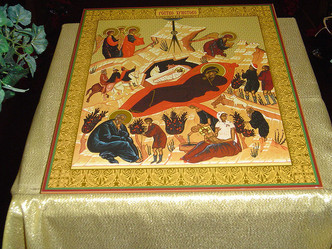 "Artwork of Orthodox Nativity Scene for Christmas" image by Desert Island Boy
One Seasonal Writing Tip
This seasonal writing tip simply notes that the inspiration for the "Orthodox Christmas" article came from two sources. You might not have the exact same situation, but you can adapt. First, I happened to hear a reminder about Orthodox Christmas on a newscast.Second, and more important, I have been practicing my writing tip, "Always ask yourself whether you've just been given an article topic...about everything". I had recently written about Diwali, Christmas carolling, Hanukkah, and Kwanzaa. Why neglect this religious group? Always be on the lookout for inspiration; just like you should keep an eagle eye out for Christmas clearance sales. After all, LED Christmas lights should be bargain-priced in January
|















 RSS Feed
RSS Feed